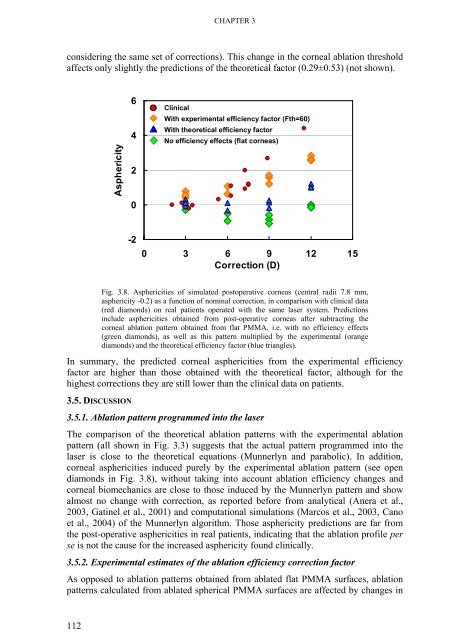Low_resolution_Thesis_CDD_221009_public - Visual Optics and ...
Low_resolution_Thesis_CDD_221009_public - Visual Optics and ...
Low_resolution_Thesis_CDD_221009_public - Visual Optics and ...
Create successful ePaper yourself
Turn your PDF publications into a flip-book with our unique Google optimized e-Paper software.
CHAPTER 3<br />
considering the same set of corrections). This change in the corneal ablation threshold<br />
affects only slightly the predictions of the theoretical factor (0.29±0.53) (not shown).<br />
Asphericity<br />
6<br />
4<br />
2<br />
0<br />
Clinical<br />
With experimental efficiency factor (Fth=60)<br />
With theoretical efficiency factor<br />
No efficiency effects (flat corneas)<br />
-2<br />
0 3 6 9 12 15<br />
Correction (D)<br />
Fig. 3.8. Asphericities of simulated postoperative corneas (central radii 7.8 mm,<br />
asphericity -0.2) as a function of nominal correction, in comparison with clinical data<br />
(red diamonds) on real patients operated with the same laser system. Predictions<br />
include asphericities obtained from post-operative corneas after subtracting the<br />
corneal ablation pattern obtained from flat PMMA, i.e. with no efficiency effects<br />
(green diamonds), as well as this pattern multiplied by the experimental (orange<br />
diamonds) <strong>and</strong> the theoretical efficiency factor (blue triangles).<br />
In summary, the predicted corneal asphericities from the experimental efficiency<br />
factor are higher than those obtained with the theoretical factor, although for the<br />
highest corrections they are still lower than the clinical data on patients.<br />
3.5. DISCUSSION<br />
3.5.1. Ablation pattern programmed into the laser<br />
The comparison of the theoretical ablation patterns with the experimental ablation<br />
pattern (all shown in Fig. 3.3) suggests that the actual pattern programmed into the<br />
laser is close to the theoretical equations (Munnerlyn <strong>and</strong> parabolic). In addition,<br />
corneal asphericities induced purely by the experimental ablation pattern (see open<br />
diamonds in Fig. 3.8), without taking into account ablation efficiency changes <strong>and</strong><br />
corneal biomechanics are close to those induced by the Munnerlyn pattern <strong>and</strong> show<br />
almost no change with correction, as reported before from analytical (Anera et al.,<br />
2003, Gatinel et al., 2001) <strong>and</strong> computational simulations (Marcos et al., 2003, Cano<br />
et al., 2004) of the Munnerlyn algorithm. Those asphericity predictions are far from<br />
the post-operative asphericities in real patients, indicating that the ablation profile per<br />
se is not the cause for the increased asphericity found clinically.<br />
3.5.2. Experimental estimates of the ablation efficiency correction factor<br />
As opposed to ablation patterns obtained from ablated flat PMMA surfaces, ablation<br />
patterns calculated from ablated spherical PMMA surfaces are affected by changes in<br />
112











